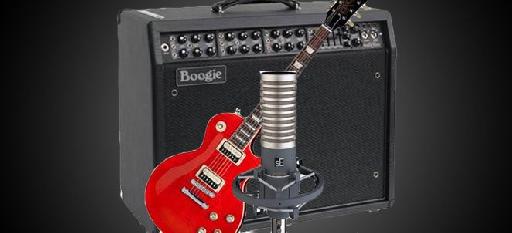We've all heard the good old sayings about ribbon mics – they're warm, musical, creamy and so on. And there's a good reason to record guitars with them – because they're warm, musical, creamy, and so on! Here's 5 easy tips to track guitars with them.
Tip 1 – Combo Time
When I track electric guitars, I typically combine a ribbon mic with something like a Sennheiser 421 or Shure SM57. Placing a ribbon with one of these - right next to each other (same distance from the speaker) will give you a fuller sonic picture of your amp. The ribbon usually gets the bottom, beefy tones, thick in the 200-2 kHz range, while the other mics handle the mids and highs.
Tip 2 – Pan Man
There are endless ways to pan the above ribbon mic combo, depending on your needs. If I'm tracking only one guitar part, I may even split them up left and right. Then I might even add some reverb or EQ to one and not to another. But If I'm doubling or multitracking, I'll pan them together to create a thicker sound.
Tip 3 – Playing Favorites
Usually, the ribbon mic wins out when it comes to pushing up the faders. The nice thing about tracking with two mics is that you have options. Push up each mics fader, and see (listen) how they blend together. Favoring the ribbon will usually give you a thicker, fuller tone. Pushing up the dynamic mics will deliver more edge. It all depends on what the production calls for.
Tip 4 – Figure 8s
When I use my Royer 121 ribbon, I place the logo side facing front (towards the amp). Most ribbons, such as the Royer 121, feature a figure 8 polar pattern. That means it will record both what's in front of the mic, and what's behind it. This lets you capture a touch of room ambience for example, when miking up your amp. So listen carefully to the space you're putting your amp in, and take advantage of the ribbon mics Figure 8 pattern.
Tip 5 – Acoustic Time
Ribbons aren't just for amps. They can sound great on acoustic guitars – warm and rich. Start somewhere around where the fretboard meets the soundhole, about 6 inches away. But that's just a guideline. Learn to use your ears and not rely on what 'should' be right. Sometimes I'll mic an acoustic's body with a ribbon and use another type of mic on the neck. Experimentation is key.



 © 2024 Ask.Audio
A NonLinear Educating Company
© 2024 Ask.Audio
A NonLinear Educating Company
Discussion
Want to join the discussion?
Create an account or login to get started!